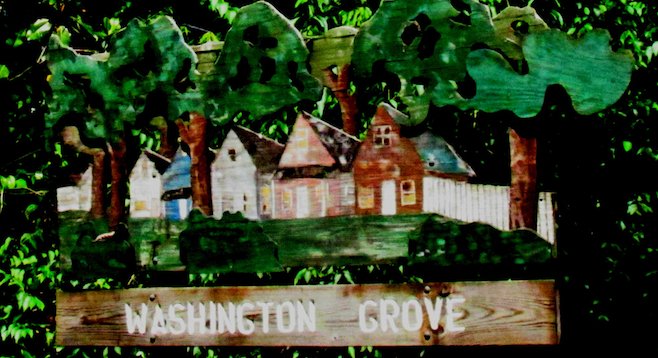 Facebook
Facebook
 X
X
 Instagram
Instagram
 TikTok
TikTok
 Youtube
Youtube

Northeast of Washington, D.C., lays a “town within a forest.” Washington Grove is a shady hamlet tucked beneath an age-old stand of forest. It’s a town built purposefully around trees, one of the early intentionally planned garden cities.
The garden city was a concept initiated by Ebenezer Howard in 1898 to address the pollution and overcrowding resulting in cities due to the Industrial Revolution. Unlike nearby Greenbelt that earned its fame for having been F.D.R.’s federal social housing venture, Washington Grove was a private venture.
Founded by Methodists from D.C. looking for a summer revival camp away from the heat of the city on 267.5 acres along the Baltimore & Ohio Railroad Metropolitan Line, Washington Grove began – like Coronado – as a tent city. Only it was religious zealots who found shelter beneath the canvas roofs rather than beachgoing tourists.
On July 4th, 1873, they held their first country revival meeting, where 258 tents were laid out. The following year saw the establishment of the “Sacred Circle” taking the place of a town “green” but equipped nonetheless with a speakers' platform. Tent sites were laid out in spurs around the perimeter-long six (and later seven) avenues that radiated from it. More than 10,000 visitors were reported to have attended.
By 1905, the chapel and assembly hall built for services had exceeded capacity. Those who weren’t drawn to the village for the revival meeting were lured by the nonreligious programming that consisted of lectures on literature, philosophy, music and self-improvement of all things.
Over the years, the number of tents being erected continued to grow, and eventually, those coming for the two-week revival stayed the summer, then through the mild mid-Atlantic autumns. Canvas walls were slowly replaced with wooden ones until the tents were replaced completely by gothic cottages with steep rooflines that mimicked those of the peaked tents. The cottages were erected directly on the tent platforms, which were only 15 feet wide. By 1920, Washington Grove was a permanent community with year-round residents living in very tiny houses.
Described as an “oasis of tranquility and rustic jewel," it is clear that care went into developing and preserving this vintage gem, hidden beneath a lush canopy of mature trees amidst otherwise unchecked urbanization. Trees were given priority over housing from the onset. Resolutions were passed that managed growth and property ownership that would serve to prevent future owners from monopolizing and expanding the historic units. And, after a short-lived wave of post– World War II housing, the town ceased all development; thus, the East Woods would never be developed, leaving a large buffer surrounding the town.
The streets are named after trees and the vehicular roads are placed behind the homes in the back alleyways. The “avenues” along the front of the homes remain to this day strictly pedestrian footpaths.
Washington Grove, with its clapboard and shingled gingerbread cottages, was listed on the National Register of Historic Places in 1980.


Northeast of Washington, D.C., lays a “town within a forest.” Washington Grove is a shady hamlet tucked beneath an age-old stand of forest. It’s a town built purposefully around trees, one of the early intentionally planned garden cities.
The garden city was a concept initiated by Ebenezer Howard in 1898 to address the pollution and overcrowding resulting in cities due to the Industrial Revolution. Unlike nearby Greenbelt that earned its fame for having been F.D.R.’s federal social housing venture, Washington Grove was a private venture.
Founded by Methodists from D.C. looking for a summer revival camp away from the heat of the city on 267.5 acres along the Baltimore & Ohio Railroad Metropolitan Line, Washington Grove began – like Coronado – as a tent city. Only it was religious zealots who found shelter beneath the canvas roofs rather than beachgoing tourists.
On July 4th, 1873, they held their first country revival meeting, where 258 tents were laid out. The following year saw the establishment of the “Sacred Circle” taking the place of a town “green” but equipped nonetheless with a speakers' platform. Tent sites were laid out in spurs around the perimeter-long six (and later seven) avenues that radiated from it. More than 10,000 visitors were reported to have attended.
By 1905, the chapel and assembly hall built for services had exceeded capacity. Those who weren’t drawn to the village for the revival meeting were lured by the nonreligious programming that consisted of lectures on literature, philosophy, music and self-improvement of all things.
Over the years, the number of tents being erected continued to grow, and eventually, those coming for the two-week revival stayed the summer, then through the mild mid-Atlantic autumns. Canvas walls were slowly replaced with wooden ones until the tents were replaced completely by gothic cottages with steep rooflines that mimicked those of the peaked tents. The cottages were erected directly on the tent platforms, which were only 15 feet wide. By 1920, Washington Grove was a permanent community with year-round residents living in very tiny houses.
Described as an “oasis of tranquility and rustic jewel," it is clear that care went into developing and preserving this vintage gem, hidden beneath a lush canopy of mature trees amidst otherwise unchecked urbanization. Trees were given priority over housing from the onset. Resolutions were passed that managed growth and property ownership that would serve to prevent future owners from monopolizing and expanding the historic units. And, after a short-lived wave of post– World War II housing, the town ceased all development; thus, the East Woods would never be developed, leaving a large buffer surrounding the town.
The streets are named after trees and the vehicular roads are placed behind the homes in the back alleyways. The “avenues” along the front of the homes remain to this day strictly pedestrian footpaths.
Washington Grove, with its clapboard and shingled gingerbread cottages, was listed on the National Register of Historic Places in 1980.
Comments